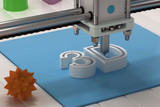European Space Agency 3D printing electrically conductive CubeSats in PEEK

PEEK into space
Space Materials & Technology Specialist, Ugo Lafont explains his branch of the ESA is currently focused on “3D printing using ‘polyether ether ketone’ – or PEEK.” This is because the advanced thermoplastic has “very good intrinsic properties in terms of strength, stability and temperature resistance, with a melting point up around 370ºC.” The 3D printed PEEK CubeSat is light, and compared to other satellite fabrication methods, cheap to produce. 3D printing was also used recently by Indian teenager Rifath Sharook, to develop “the world’s lightest satellite.”
25th May 2017
Recent Posts
-
Best Computer Screens for Home and Office
Computer display screens, often referred to simply as monitors, have undergone a remarkable evolutio …27th Dec 2023 -
Unleashing Creativity Down Under: The Best 3D Printing Filament Options in Australia
Australia has become a hub for creativity and innovation, and 3D printing is no exception. With an …3rd Jun 2023 -
How is 3D Printing Technology enhancing the Advertising Industry?
3D printing, or additive manufacturing, is the process of using digital files to create three- dime …8th May 2023

 FREE SHIPPING ON ORDER OVER $75
FREE SHIPPING ON ORDER OVER $75
 LOYALTY PROGRAM
LOYALTY PROGRAM
 SHIPPING WORLDWIDE
SHIPPING WORLDWIDE


